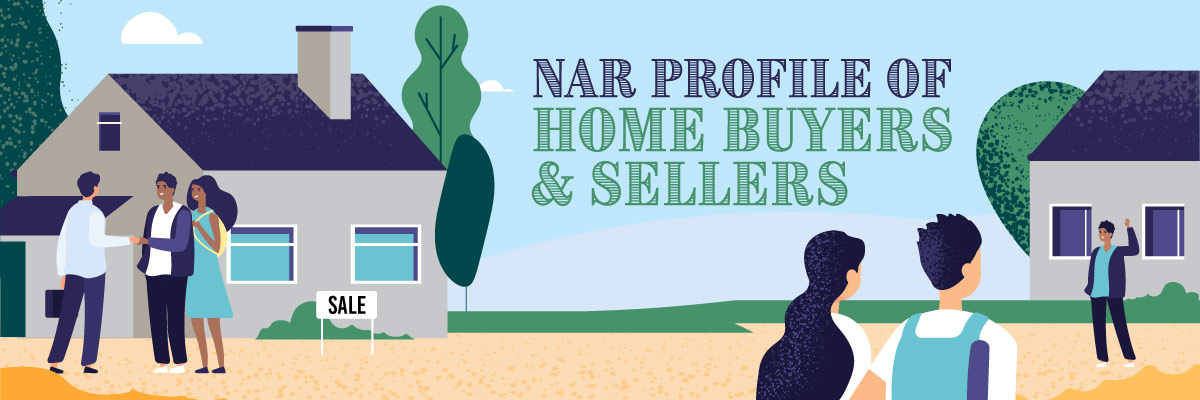NAR’s 2021 Profile of Home Buyers and Sellers: What Do You Need to Know?
January 28, 2022

Late last year, the National Association of REALTORS® released the 2021 Profile of Home Buyers and Sellers. Published annually and based on a nationwide survey of consumers, the latest edition weighs in at more than 160 pages and is chock full of data on the characteristics, preferences, and behaviors of home buyers and sellers during the pandemic.
There is a lot of great information in this document that can be used in daily interactions with clients. Here are my Top 10 takeaways:
- More people are buying multigeneration homes. In 2021, 11% of home buyers purchased a multigenerational home. The main reasons for buying a multigenerational home were to take care of aging parents, because of children over the age of 18 moving back home, and for cost savings. Single-female buyers were more likely than other buyers to purchase a multigenerational home.
- Senior living is becoming more in-demand. About 14% of all buyers over age 50 purchased a home in senior-related community (e.g., active adult, over 55 community, senior independent living). Only about 3% of these purchases nationally were in a multi-unit condominium building. The vast majority of senior home purchases were detached single-family homes (68%).
- Most home buyers do not have children. The share of childless buyers has been rising steadily over the past few years. In 2021, 69% of home buyers had no children under 18. Only 31% of buyers had children, and that share has declined from 41% in 2012.
- Share of first-time buyers ticked up in 2021. First-time home buyers accounted for 34% of all sales in 2021, which is up from 31% in 2020. However, the first-time home buyer share remains below long-term averages. Historically, about 40% of buyers have been first-time buyers.
- People tend to move short distances. The median distance between the home that recent buyers purchased and the home they moved from was only 15 miles. Buyers in the south moved the greatest distance, at a median of 20 miles. The most common move was suburb-to-suburb (67% of all moves), followed by urban/city to urban/city (48%).
- Some people did move to small towns, rural areas, and resort communities during the pandemic. In 2021, 20% of buyers purchased in a small town, 12% in a rural area, and 3% in a resort/recreation area. However, the suburbs remained the biggest draw, with 51% of homes purchased in suburban communities.
- Neighborhood matters, but so do friends and family. After quality of the neighborhood, convenience to friends and family was the second most important factor in influencing neighborhood choice. This outranked convenience to job and affordability, which were more important in 2020. Among households with children, school quality and convenience to job were tied for the second most important factor influencing neighborhood choice.
- Buyers looked at fewer homes during the pandemic. In 2021, buyers typically searched for eight weeks and looked at a median of eight homes, including three homes that they viewed only online. By comparison, buyers’ home searches lasted between 10 and 12 weeks prior to the pandemic.
- Even in a hot market, FSBO’s were rare. In 2021, only 7% of home sales were for sale by owner (FSBO). This share is down slightly from a year ago and is at a record low since NAR began collecting this data in 1981.
- Nearly every buyer and seller would recommend their agent to others. Ninety percent of buyers would use their agent again or recommend their agent to others. In fact, 20% of buyers in 2021 had already recommended their agent four or more times. Among sellers, client referrals and repeat business were the most common ways they found their real estate agent. And most sellers (89%) said that they would definitely (74%) or probably (15%) recommend their agent to others.
For more on the characteristics of home buyers and sellers, check out NAR’s Generational Trends report, which provides insights into differences and similarities across generations of home buyers and sellers.
Click here to send any comments or questions about this piece to Virginia REALTORS® Chief Economist Lisa Sturtevant, PhD.
You might also like…
5 Key Takeaways from the NAHREP 2023 State of Hispanic Homeownership Report
By Sejal Naik - April 17, 2024
In March 2024, the National Association of Hispanic Real Estate Professionals (NAHREP) released its 2023 State of Hispanic Homeownership Report. Using data from surveys conducted by various public… Read More
3 Multifamily Market Trends from the First Quarter
By Dominique Fair - April 16, 2024
For the last three years, the multifamily market has seen high demand, double digit rent growth, and increased construction to meet demand. These trends are expected to shift… Read More
Virginia’s Housing Market Sees Largest Influx of New Listings Since 2021
By Robin Spensieri - March 29, 2024
According to the February 2024 Virginia Home Sales Report released by Virginia REALTORS®, pace in Virginia’s housing market picked up last month. There were 6,733 homes sold statewide in February,… Read More